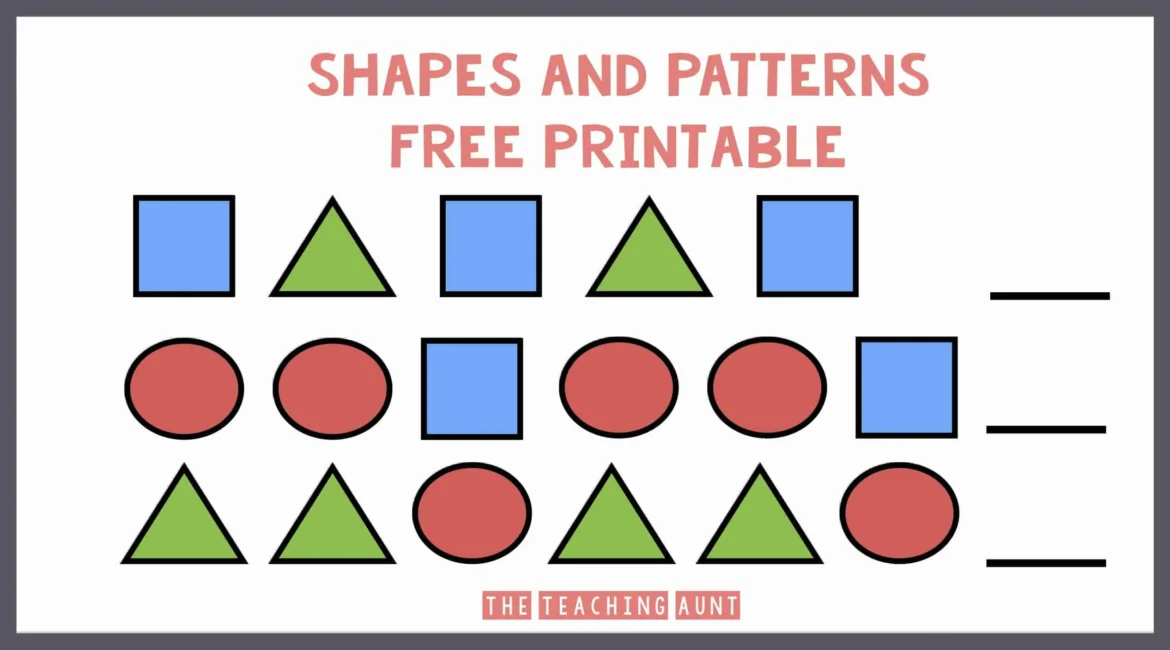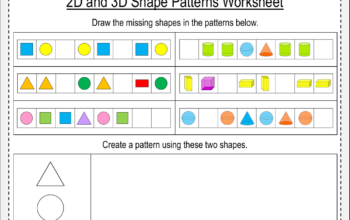Shape pattern worksheets are an excellent tool for young learners, particularly in kindergarten, where foundational skills are being developed. These worksheets help children grasp key concepts such as shape recognition, sequencing, and pattern completion, which are critical for their cognitive growth. They are not only fun but also foster essential skills that prepare children for more advanced learning in math, reading, and problem-solving. As simple as it may seem, the task of completing a shape pattern worksheet allows kids to enhance their focus, fine motor skills, and understanding of basic concepts that are vital for their academic development.
By incorporating shapes into fun and interactive patterns, teachers and parents can help children form connections between visual elements and sequence logic. Through repetition and practice, young minds start recognizing patterns in their surroundings, which strengthens their analytical and cognitive abilities. This article will explore why shape pattern worksheets are so beneficial for kindergartners and provide helpful tips on how to use them effectively.
Why Shape Patterns Matter for Kindergarten Kids
Patterns are an essential concept for children to understand, as they are present in almost everything around us. Recognizing patterns helps children develop important cognitive and problem-solving skills. Shape pattern worksheets play a pivotal role in introducing young learners to these essential skills in a structured yet enjoyable way. When children complete pattern exercises, they develop their ability to predict and continue patterns, which boosts their logical thinking abilities.
In kindergarten, children are still in the early stages of developing their critical thinking and analytical skills. Working with shape patterns helps them recognize order, symmetry, and repetition. By associating shapes with patterns, children begin to see the world in a more structured way. This early exposure to patterns helps children understand more complex concepts later on, such as numbers, time, and even reading patterns.
Additionally, engaging with shape patterns at this stage fosters problem-solving skills. Kids learn to identify missing elements or predict what comes next, which nurtures their ability to think critically. Recognizing patterns also supports math skills by laying the groundwork for understanding sequences and arithmetic in future lessons.
Benefits of Using Shape Pattern Worksheets in Kindergarten
Shape pattern worksheets for kindergarten are much more than just a fun activity; they offer numerous developmental benefits for young children. One of the primary advantages is that they help children recognize and become familiar with basic shapes such as circles, squares, triangles, and rectangles. This skill is vital as it is the building block for more complex math concepts. Understanding shapes not only helps in math but also aids in spatial awareness, an important skill in both academic and daily life.
In addition to shape recognition, completing shape patterns on worksheets promotes fine motor skills. Activities like tracing, coloring, and drawing the shapes or completing the patterns require children to use their hand muscles and improve their coordination. As a result, these exercises play a role in strengthening their hand-eye coordination and control.
Shape pattern worksheets also support children’s memory and concentration. When children are required to focus on completing a pattern or predicting the next shape, they are enhancing their ability to concentrate on tasks. Moreover, the act of recognizing and completing patterns reinforces their memory retention. As they recall previous patterns or sequences, they improve both their short-term and long-term memory.
Types of Shape Patterns for Kindergarten Worksheets
Shape pattern worksheets for kindergarten come in a wide variety of forms to engage children with different levels of complexity. The most basic patterns begin with simple shapes such as circles, squares, and triangles. These patterns can be repeated in simple sequences such as alternating shapes (e.g., circle, square, circle, square) or progressing in a repetitive pattern (e.g., square, square, square).
As children grow more comfortable with simple shapes, more complex patterns can be introduced. These may include mirrored patterns, where children need to identify symmetry (e.g., square, triangle, square, triangle) or sequences that use various shapes together. For instance, a worksheet may feature a pattern with a sequence of square, triangle, circle, square, triangle, asking the child to predict what comes next.
Additionally, fun and creative shapes such as fruits, animals, or toys can be used to make patterns. These visual elements not only capture children’s attention but also help them relate patterns to real-world objects. This approach makes learning more engaging and allows kids to form connections with the world around them. Offering various types of patterns encourages creative thinking and helps children understand the diversity of shapes and their properties.
How to Use Shape Pattern Worksheets Effectively
To get the most out of shape pattern worksheets, it’s important to use them in a way that aligns with the child’s developmental stage. Teachers and parents can start by introducing simple patterns and gradually increase the complexity as the child becomes more confident. For example, beginning with basic shapes and alternating patterns can build a solid foundation, and later worksheets can challenge the child with more intricate sequences or patterns that involve multiple shapes.
It’s also essential to encourage active participation. Instead of just having children complete the patterns, engage them in discussions about the shapes. Ask them questions like “What comes next?” or “Why do you think this shape fits here?” This interactive approach promotes deeper thinking and understanding.
Children should also be encouraged to create their own patterns after completing the worksheets. This allows them to apply what they’ve learned creatively and reinforces their understanding of patterns. Teachers and parents can offer tools like colored pencils, stickers, or stamps to make the task more exciting and interactive.
Additionally, it’s beneficial to praise children for their efforts, not just the correct answers. This helps build their confidence and motivation to continue learning. Regular practice with shape pattern worksheets can help children refine their skills and keep them engaged.
Free Printable Shape Pattern Worksheets for Kindergarten
Finding free printable shape pattern worksheets can be an easy and cost-effective way to incorporate this valuable learning tool into your child’s education. Several websites offer high-quality, downloadable worksheets that are perfect for kindergarten students. Websites like Teachers Pay Teachers, Education.com, and Pinterest have a wide range of printable worksheets that cover different aspects of shape patterns.
These printable worksheets are not only free but also customizable. Teachers and parents can choose patterns that suit their child’s learning level and interests. For example, some worksheets may focus on basic shapes, while others incorporate fun themes like animals, nature, or transportation. Having access to a variety of worksheets allows parents and teachers to provide diverse learning experiences, which can cater to the different needs and preferences of the child.
It’s also a good idea to print these worksheets in color to keep children engaged. Many websites offer these printable resources in both black and white and color, so you can choose the one that works best for your child. Providing a range of activities helps keep children excited about learning and ensures that they continue to develop their shape recognition and patterning skills.
Conclusion
Shape pattern worksheets are an incredibly valuable tool in early childhood education. Not only do they enhance children’s ability to recognize and understand shapes, but they also strengthen their cognitive, memory, and problem-solving skills. By incorporating these worksheets into a child’s daily learning routine, parents and educators can provide an enjoyable and enriching experience that will help children prepare for more advanced subjects in the future.




